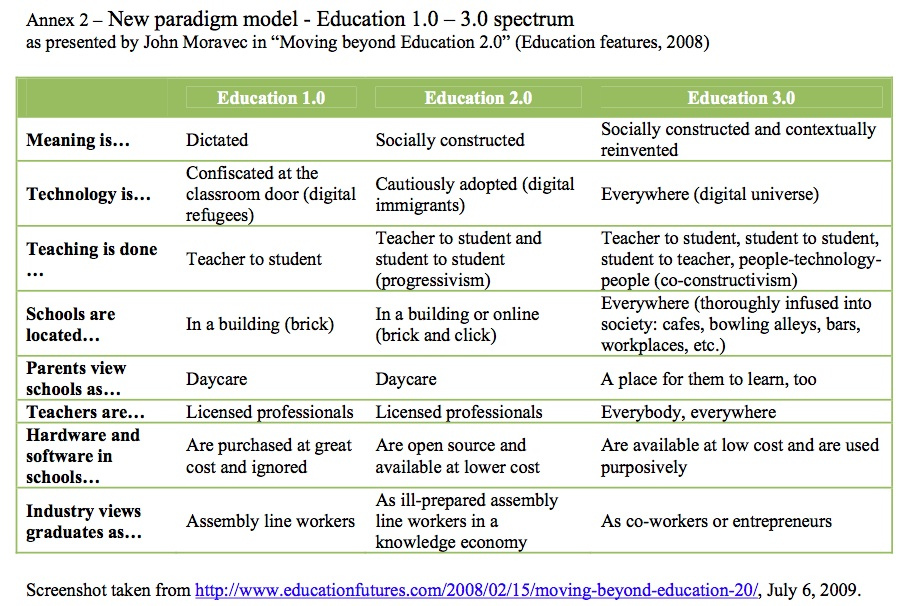And when I a saw this visual in the User Generated Education blog article, Schools are doing Education 1.0; talking about doing Education 2.0; when they should be planning Education 3.0

I began to think about my own experiences at the Korea International School, Jeju,
and how my school works to achieve seamless integration of technology.
It has been a bumpy ride at times....
I don't think KIS has achieved seamless technology integration yet, but I do believe it is a goal the administration and teachers strive to achieve. I think there are a few things that hinder integration. Miscommunication is one facet to consider, especially since KIS is an English medium school immersed in the South Korean countryside. Sometimes what is posted in Korean on the website does not reflect the English meaning of words or phrases.
Experience with technology is another factor that can hinder integration. Although we have professional development trainings several times during the year, it does not mean that teachers universally adopt all of the programs. Just because an event is posted to the Google calendar doesn't mean that people won't overlook it or simply not check to see if something else is planned.
Another factor is the 1 to 1 Macbook program. High School and Middle School teachers use CourseSmart for their classes, but because the Elementary School students do not have their own laptop and school email accounts, the ES teachers use technologies at their discretion in their classrooms. The Grade 4 Social Studies is supposed to use an e-textbook, but they can't access it easily at school. Secondary students are constantly creating Google documents, forms, spreadsheets, and presentations, but if I want my students to use Keynote or write emails with Gaggle accounts I set up for them, we need to go to the Mac Tech lab in the basement.
But it's getting better. All teachers use PowerSchool and AtlasRubicon for grading and lesson plans, and parents and students can log into these sites to see assignments, grades, and curriculum. The school is only two years old, and as problems arise with technology integration, there is an effort made to fix things rather than bury heads in the sand. We have another iPad cart, a classroom set of iPads, new laptop charging stations being set up in classrooms, new initiatives like ClassDojo for positive (and negative) feedback, and new faculty specifically designated for tech support and integration in all three schools.
Really, I see a mix of things happening as we grapple with the models (see the chart above again) of an Education 1.0 school, an Education 2.0 school, and an Education 3.0 school. I see myself blending some of the practices on each of the columns.
(Some) technology is confiscated at the classroom door (Education 1.0). I do take the Grade 3 students' cell/smart phones at the start of the day and leave them in a basket so they can't access them during the school day. Unfortunately, some students in other grades have abused the privilege of having a phone, and they maliciously took pictures of confidential information or tried to cheat on assessments, and so we have a policy in place to try to prevent some of this from happening. I also monitor the students as they use iPads and Macs. A firewall and filter doesn't always eliminate inappropriate images from appearring on screens. So technology has some restrictions, but I don't think I would be comfortable with young children just having free-reign online.
My teaching is done, I think in many ways, in an Education 2.0 style. I have a blend of teacher to student and student to student interactions, and I'm looking forward to the end of May (as an end of the year activity) as I try to facilitate a student - technology - student project with our pen pals at Hidden Oak Elementary School. I want the students from both Grade 3 classes to develop a webpage (maybe using a wikispace) comparing and contrasting Jeju, South Korea with Gainesville, Florida.
Parents view KIS as a place for them to learn, too (Education 3.0). I think that is why some parents enrolled their children at KIS in the first place. So that they might get more insight into the American style of education/learning. I can remember one mother telling me at a meeting last year that her son asks so many more questions about things after spending a few months learning in my classroom. As if being inquisitive was a foreign concept! But she learned something from her child. He's more curious about the world than she thought.
I guess my vision for technology would be that as it becomes more integrated into society as a whole, it will make us all start asking more questions and help us to seek more answers. I think KIS is making an effort to produce students who will one day be adults who can cope and adapt to all of the rapid changes in technology and seek answers to tough questions.
I love to read about how other schools work and their progress through technology integration. It sounds like you are on the path to some great learning. There are always stumbling blocks but sounds like with the right collaboration things are working out in a positive way. Sometimes it is really frustrating when you want something to work and it doesn't, but you really need it to, and others do not see the importance, that can be a downer. Asking questions for the teacher to their administrators about technology integration is one way to start conversations. Having your students ask questions is one of the most important gifts you can give them. To be curious, have a love of learning and want to know the why instead of memorizing facts, now that is teaching! With or without technology!
ReplyDelete